Graham is off visiting the queen this week, leaving me in the driver's seat.
There are lots of jobs to do in the late autumn garden this weekend. Its tidy-up time in my garden and it's time to make good use of some of our fabulous autumn fruit. So without any further ado let's get things started!

No time for fooling around. there's work to be done! Photo - Linda Ross
Its Time To
Tidy Up
It's all about house-keeping this weekend. Sweeping up, pruning off, and sprucing up! Get rid of all the scrappy-looking leaves from finishing summer plants
like agapanthus.
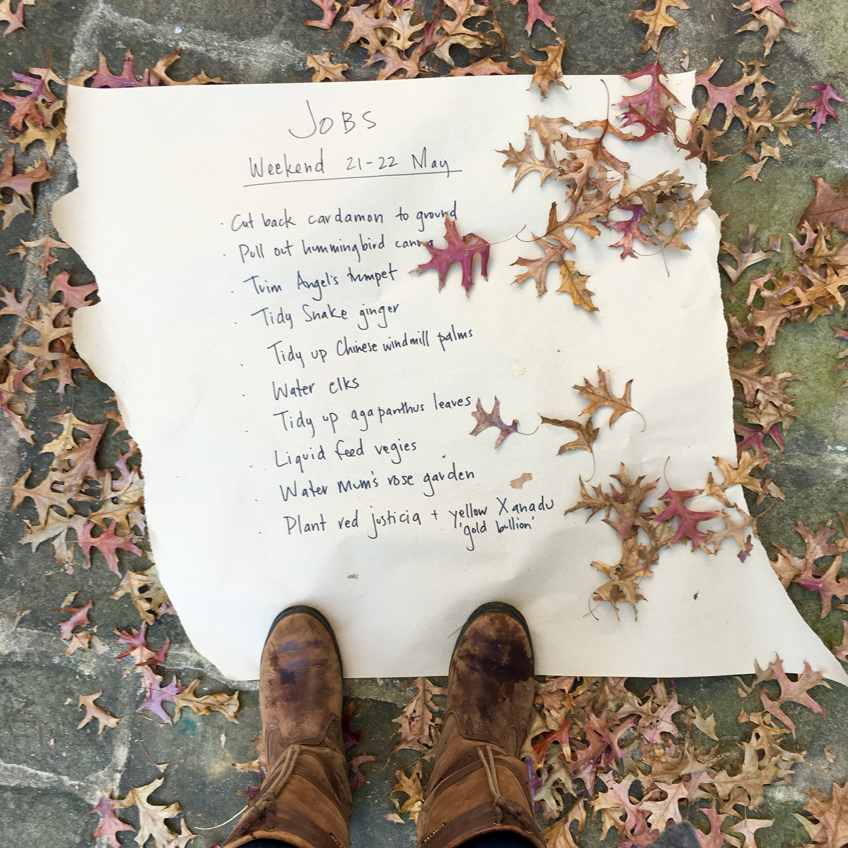
This weekend I've made myself a 'to-do list' to keep me focused. Photo - Linda Ross
Prune
Trim grevilleas and butterfly bush (Buddleia) by at least one-third, to keep them compact and long-lived.
Rejuvenate
Old and tired hydrangeas can be revived by drastically pruning them back by one-third. Remove weak branches. Prune healthy stems back to a pair of healthy
buds.
Admire
The flower panicles of cane begonias have an airy delicacy but they grow readily from cuttings, so share with your friends.
Fuchsia are prolific flowerers in the garden, or in hanging baskets – as long as you can keep the water up to them. Trim by half after flowering.
Watch out for
Hard dots on camellia, figs and citrus is likely to be scale. Eco oil will fix it up.
Want to know more about autumn jobs to do in your garden? check out the full article, It's Time To: May
Bush Garden
Callistemon 'Injune'
Callistemon 'Injune' (C. quercinus) is the prettiest little tree with a weeping growth habit, usually up to 2-4 metres high. It has pointed spear-shaped
leaves to about 7 cm long. The pale pink bottlebrush-shaped flowers, fading to white as they grow older, will cover the tree in spring with a second
flush in late summer/autumn. It's become very popular in home gardens because it's so attractive and hardy for a wide range of soils, including clay,
and climates, even cooler climates like up in the Blue Mountains. It prefers a sunny position and moist soils and is tolerant of at least moderate
frost. It withstands extended dry conditions once established. Like other callistemons, it'll need annual feeding after flowering. This specimen is
growing in Bilpin in our friend Peta's garden with Smoky her cat.
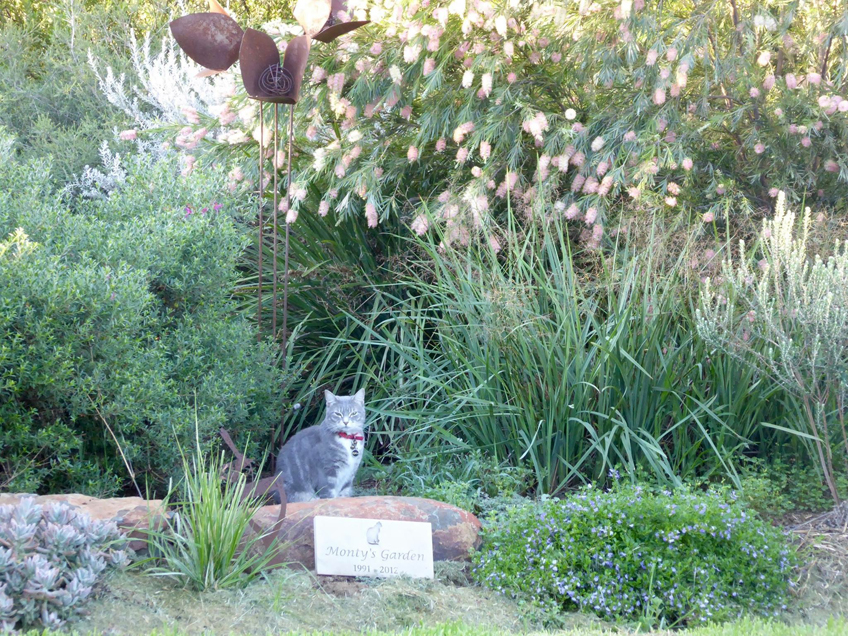
Callistemon 'Injune', and Smokey they cat. Photo - Peta Trahar
If you would like to know more about selecting and caring for a bottlebrush have a look at my article, How To Grow Bottlebrush.
Bugwatch
Citrus Gall Wasp
Gall wasp is about in citrus at the moment, and can be a huge problem if not controlled. Unfortunately, once it arrives in your tree the only effective
control for this vitality-sucking critter is to prune off the affected wood, and dispose of it in the bin, not the compost.
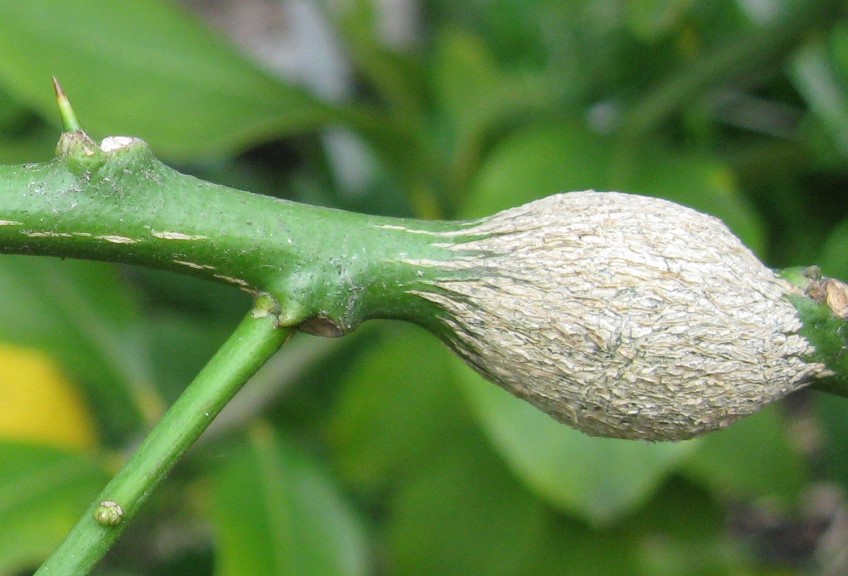
Citrus gall wasp affected stem. Photo - Linda Ross
Bulging citrus stems, like this, indicate the presence of the citrus gall wasp, which lays its eggs in the bark at the ends of citrus branches.
In the Veggie Patch
Green Smoothies
How do we get through all the greens we grow in the garden? We drink armfuls of them – as a green smoothie for lunch a few times a week.

Graham and his super-food-green-smoothie. Photo - Linda Ross
Call it a Ross family secret for more energy and verve! A green smoothie is hydrating, quick, healthy – and delicious.
Check out our favourite recipe, How to: make a garden-grown smoothie;
feel free to tweak it to your own taste – and garden produce.
Potted Garden
Mexican Mistletoe Rhipsalis
The Mistletoe Rhipsalis family have a wonderful soft weeping habit, in a variety of leaf shapes and textures. They are also hardy, and tolerant of shade,
erratic watering and general neglect. Even better, they are easily propagated to be swapped or given away. Want more information about the best hanging
plants for your garden? Check out my recent article, Hanging Around.
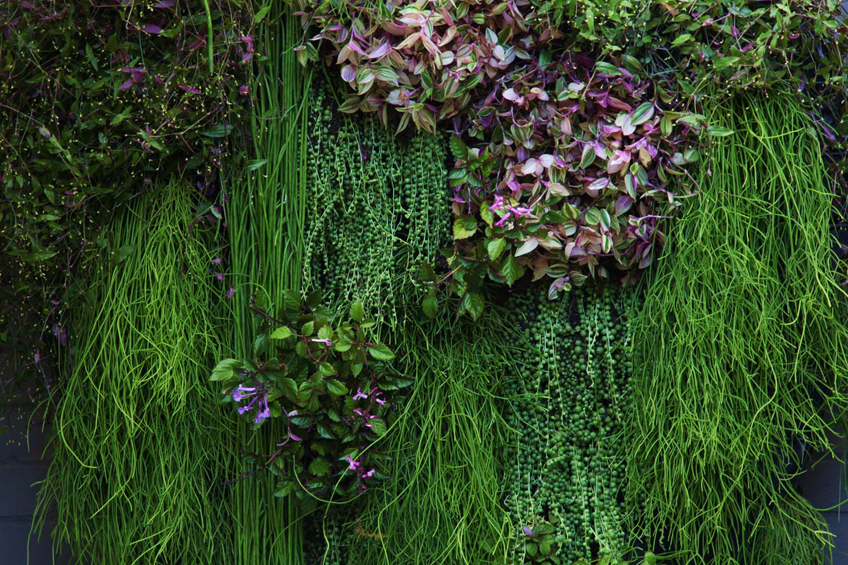
There are so many different Rhipsalis to choose from. Photo - Brendan Moar
Devils Ivy, Pothos
The plant has a multitude of common names including golden pothos, hunter's robe, ivy arum, money plant, silver vine, Solomon Islands ivy and taro vine.
It is also called devil's vine or devil's ivy because it is almost impossible to kill. It is sometimes mistakenly labeled as a Philodendron in plant
stores.
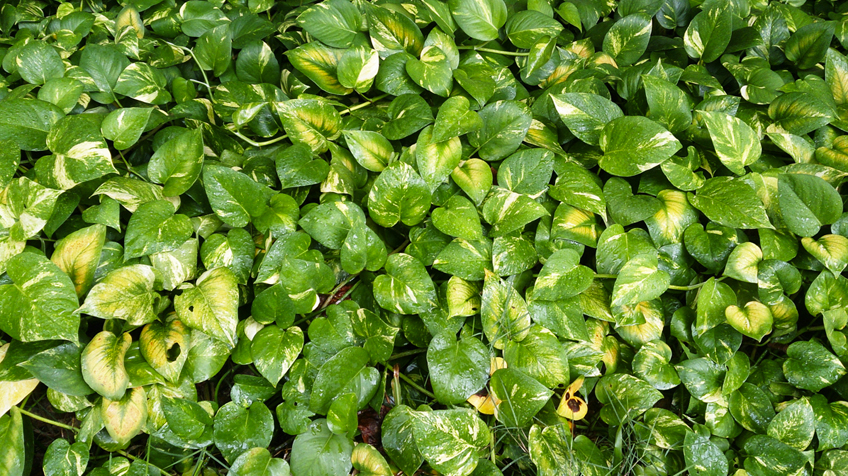
Devil's Ivy Pothos
Hoya
The best known hoya is the one shown here, Hoya carnosa, which perhaps you know as ‘wax plant’, or even, ‘that weird thing Gran had in the glasshouse’.
This shining beauty is just one of the 250 different species in the family, and it’s the one that most gardeners start with.If you would like to plant
hoya at your place check out my article, How To Grow Hoya.
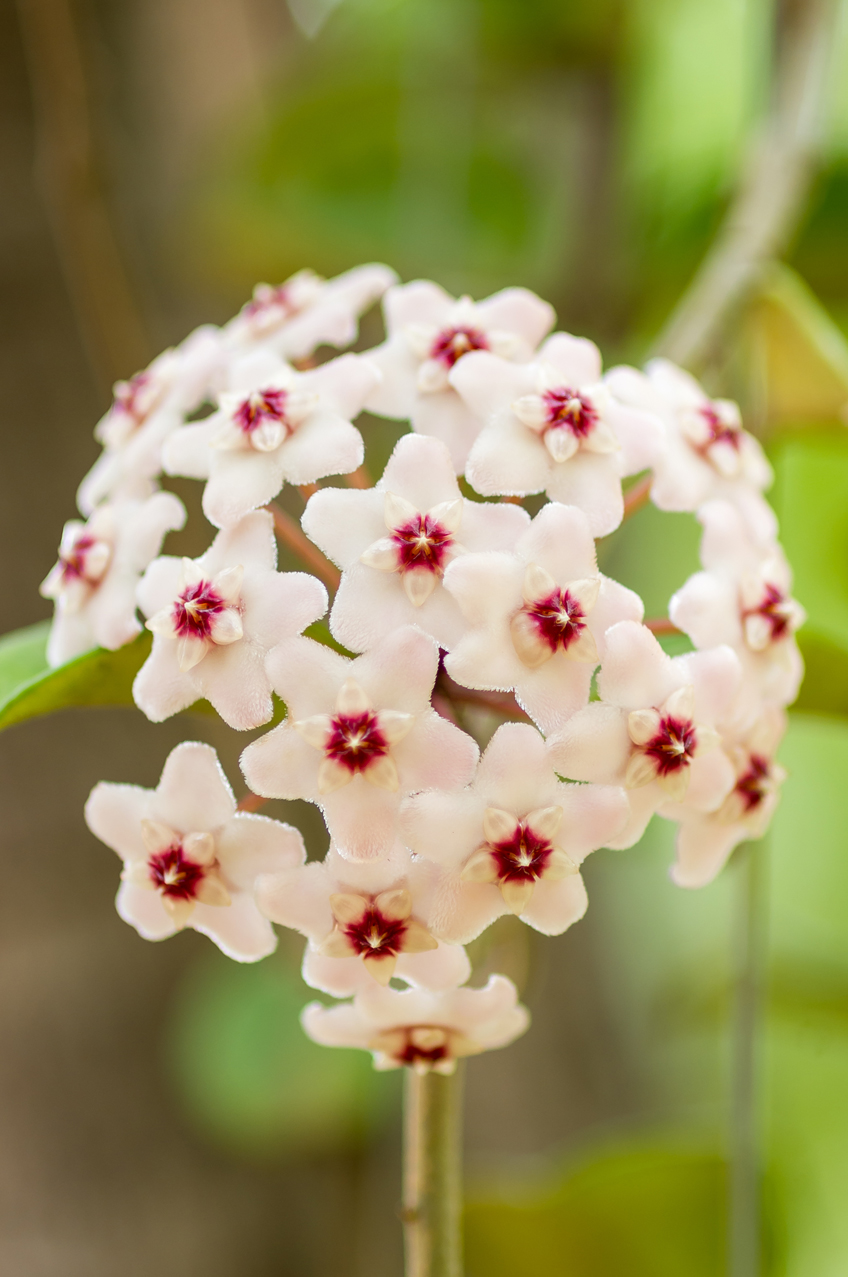
Gorgeous globes of scented flowers that last and last. Photo - Seksan44 / Shutterstock
Garden News
Aussie kid takes the world record in the veggie patch
An Eyre Peninsula teenager has entered the record books for growing the world’s largest cucumber. Keegan Meyers, 13, began growing the heirloom sweet and
striped cucumber on the Polda family farm in January.

Keegan, his sisters, and his world record-breaking cucumber.
The cucumber was given a healthy mix of fertiliser, cow manure and worms inside a glasshouse. It officially measured 130.5cm long when it was picked on
April 13. It beat the previous world record of 119.5cm held by a British grandmother.
Keegan said he did not initially intend to break the world record but was proud of his efforts.He said he would try to break the record again next year
but was unable to enjoy the fruits of his labour because the cucumber — fed to the family’s chickens — was too ripe.
Mum Heather Meyers said she was impressed her son had claimed a world record.
The sweet and striped cucumber usually grows about 1m long and is described as elegantly curled and burp-free.

The world record cucumber measured 130.5 cm and needs to be suspended on hammocks!
Graham chats with us about the Chelsea Flower Show Fields of Poppies display
A breathtaking display of thousands of handmade poppies is laid out from the showground to the Royal Hospital at this years Chelsea Flower Show. Designer
Phillip Johnson, who won Best Show Garden at the 2013 Chelsea Flower Show, is the creator behind the exhibit. Using almost 300,000 individually crocheted
poppies collected from all over the world, Phillip’s garden design covers nearly 2,000sq m in the grounds of the Royal Hospital Chelsea, and show visitors
can admire his work from the showground.

The carpet of crochet poppies at the 2016 Chelsea Flower Show. Photo - Graham Ross
Come away with us
NSW Spring Festivals
A plant lover’s delight as we follow the trail of flower festivals across NSW meeting friendly gardeners along the way. We start in Southern Highlands for Tulip Time, then Canberra for Floriade, then Cowra to catch the Cherry
Blossom and finally to the Leura Gardens Festival.
Go to the Ross Tours website, or call
Royce or Roslyn at Ross Tours to reserve your place on 1300 233 200 for more details on the tour.

The beautiful spread awaiting you at Glenmore House, just one of the destinations on the NSW Spring Festivals tour.
Last Chance To:
Pick persimmons at the Persimmon Place
Head out to Dural today for a swagful of end of season persimmons, and the Persimmon Place is the perfect spot, at 377 Galston Road Dural
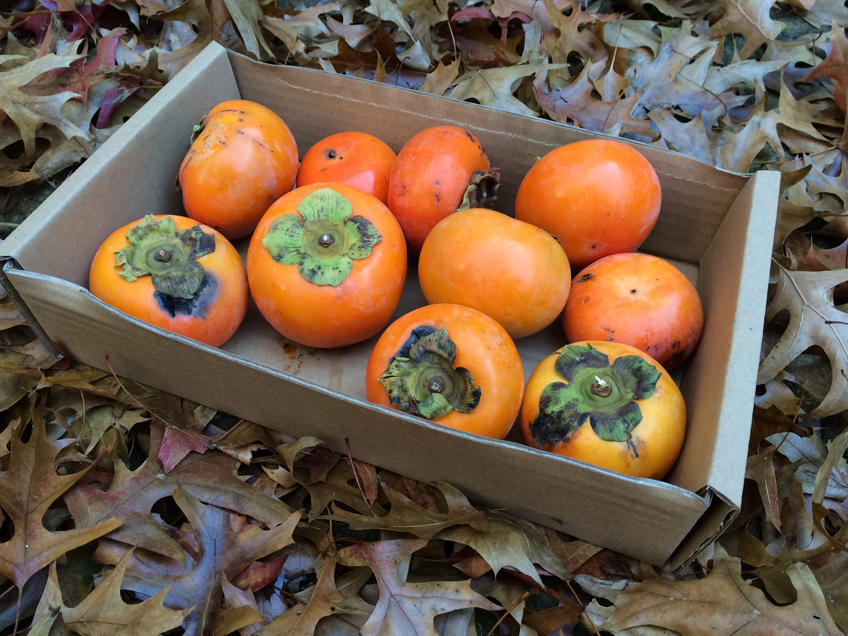
A pack of perfect persimmons! Photo - Linda Ross
Pick your own Pink Lady Apples
The very last of this years extrordinary pink lady apple crop is ripe for the picking in Bilpin this weekend, so now is the time to get up there and bring
home a box full. TNT Produce is the place, up at Kurts Road Bilpin.
What to do with all these apples?
Apple Chutney (thanks Nigella!)
My favourite chutney recipe from Nigella Lawson uses plenty of apples. Taken from How to be a Domestic Goddess it is simplicity itself. The resulting chutney
is excellent with cold pork, sausages and stirred through soups and curries to give them a sweet and spicy kick. I normally double the recipe quantities
to make about two litres of chutney, spooned into old vacola jars this is enough to see us through until the next year. A water bath will give them
a two year life expectancy. And yes you can use half pears and half apples too!
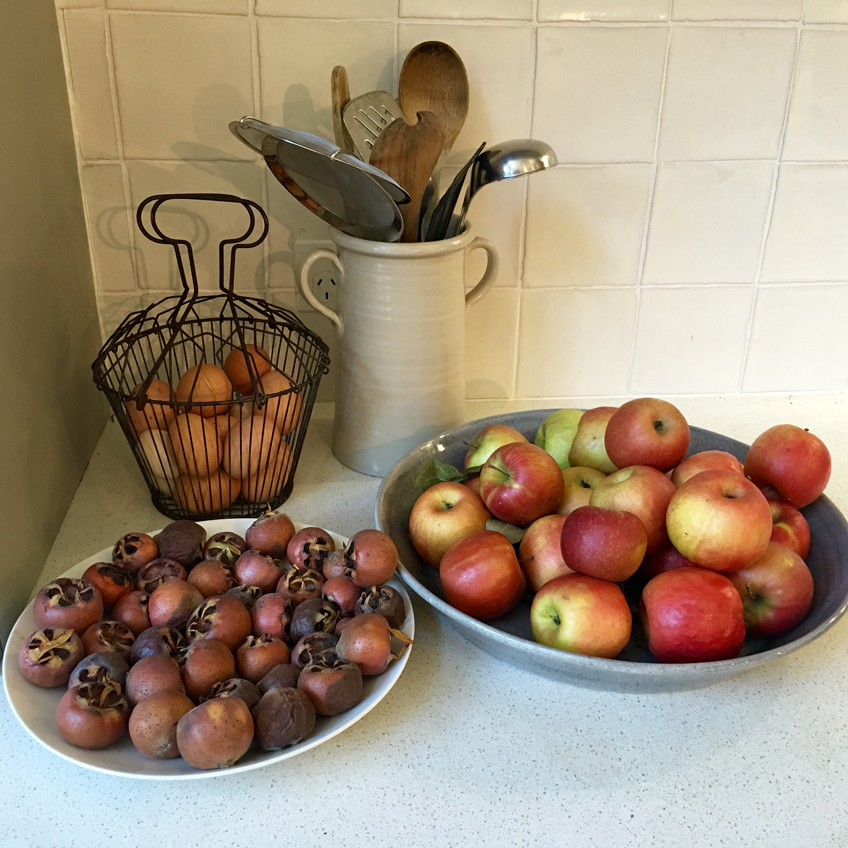
Here are some of the pink lady apples my daughter, Melaleuca picked for me. I used them to make Nigella Lawson's apple chutney. The fruit on the left are called medlars. Photo - Linda Ross
500g pink lady apples, peeled and roughly chopped
1 med onion, finely chopped
2 red chillies, seeded and chopped
3 tablespoons Mustard seeds
250g demerara sugar
1 tsp ground allspice
1 tsp ground cloves
1/2 tsp sea salt
black pepper
1 heaped tbsp chopped ginger
1 tsp turmeric
350ml Apple cider vinegar
Makes 1 litre
Approx. 4 x 250l jars or equivalent
Place all the ingredients in a pan and bring to the boil. Cook over a medium heat for about 40 mins, until the mixture thickens into a jammy consistsncy.
Ladle into the jars and leave to cool.
Place them in a Water bath for 60 mins to extend their pantry life